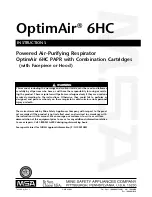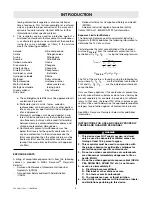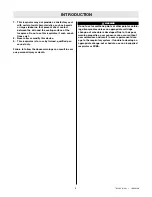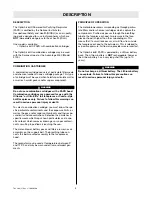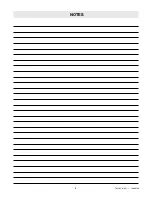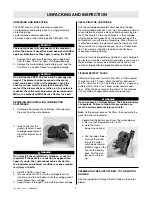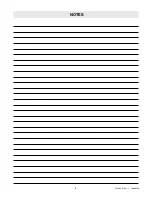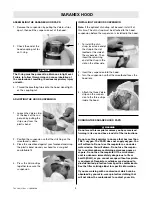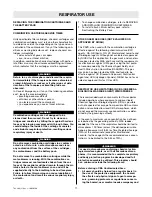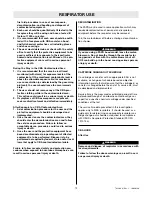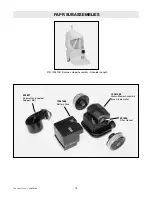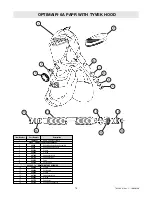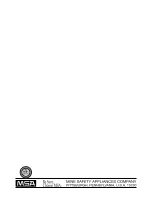
RESPIRATOR USE
first aid procedures in case of overexposure,
decontamination, and handling and disposal of
contaminated equipment.
2. Each user should be quantitatively fit tested in the
facepiece they will be using and have a tested fit
factor of 1000 or greater.
3. It is recommended that each user should be outfit-
ted with a facepiece with CBA canister, a hood,
and full chemical protective suit including gloves
and shoe coverings.
4. The user would determine or check with the safety
office to verify that the protective equipment to be
used is sufficient for exposure to their particular
hazard and contamination level. Misuse of the pro-
tective equipment can result in serious personal
injury or death.
During the Stay in the CBA Contaminated Area
1. It is recommended that the area be real timed
monitored (with alarm) for exposure levels of the
contaminate. If the monitored contaminate level is
above the allowable exposure limit or maximum
use concentration (as determined by the governing
protocol), the user should leave the area immedi-
ately.
2. The user should not remove any of the CBA pro-
tective clothing while in the contaminated area.
This action could result in a serious injury or death.
3. If symptoms of CBA overexposure are present,
seek medical treatment and attention immediately.
After Exposure to a CBA Contaminated Area
1. A decontamination procedure for the user and the
protective equipment should be developed and
implemented.
2. Once the user leaves the contaminated area, they
should enter the decontamination area and follow
the set decon procedure. Failure to follow an
acceptable decon procedure could lead to serious
injury or death.
3. Once the user and the protective equipment have
been decontaminated, proper disposal of affected
equipment is to be performed. Disposal is to be
performed as required by federal, state and/or local
laws that apply to CBA contaminated materials.
Failure to follow accepted safety and protection pro-
cedures when exposed to hazardous atmospheres can
result in serious personal injury or death.
DECONTAMINATION
The PAPR may be used in some applications which may
require decontamination of personal and respiratory
equipment before the respirator may be removed.
Turn the motor-blower off before entering a decontamina-
tion shower.
If you are using a PAPR hood model, leave the motor-
blower on. Do not breathe through the respirator for
long periods of time with the motor-blower shut off.
CO2 can build up in the hood, causing serious person-
al injury or death.
CARTRIDGE CHANGE-OUT SCHEDULE
If a cartridge or canister with an appropriate ESLI is not
available, a change-out schedule based on objective
information or data that will ensure that the cartridge(s) or
canister is changed before the end of its service life, must
be developed and implemented.
Service time is the measured or estimated period of time
before breakthrough of an airborne contaminant (gas or
vapor) for a specific chemical cartridge under specified
conditions of the test.
The service time data presented in this investigation
applies only to MSA respirators. It should be used as a
guide only for determining an appropriate respirator car-
tridge change-out schedule as required for compliance
with OSHA’s Respirator Protection Standard (29 CFR
1910.134).
CBA HOOD
After Use
Remove and dispose of respirator in accordance with
local requirements.
Failure to follow the above warnings can result in seri-
ous personal injury or death.
12
TAL 209 (L) Rev. 1 - 10040590
WARNING
WARNING
Summary of Contents for OptimAir 6HC
Page 6: ...NOTES 6 TAL 209 L Rev 1 10040590 ...
Page 8: ...NOTES 8 TAL 209 L Rev 1 10040590 ...
Page 15: ...15 TAL 209 L Rev 1 10040590 20 ...
Page 16: ......

